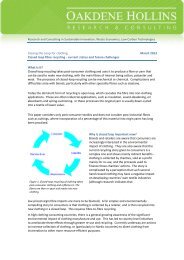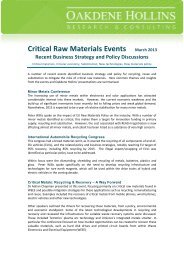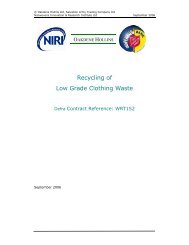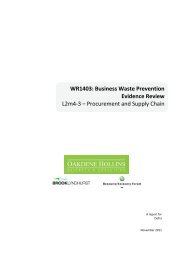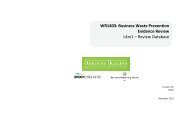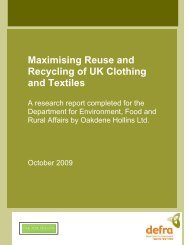Fire Retardant Technologies: safe products with ... - Oakdene Hollins
Fire Retardant Technologies: safe products with ... - Oakdene Hollins
Fire Retardant Technologies: safe products with ... - Oakdene Hollins
- No tags were found...
You also want an ePaper? Increase the reach of your titles
YUMPU automatically turns print PDFs into web optimized ePapers that Google loves.
The existence of inherent FR materials in high specification printed circuit boards offers thebest environmental performance and this may be encouraged by ecolabels. However, inregard to GPP, the cost of adopting this technology in consumer electronic <strong>products</strong> wouldbe prohibitive.While the exclusion of some brominated FRs is justified on environmental grounds, suchexclusions should not be applied to all brominated FRs that could be used in electronicproduct applications.A number of chlorophosphorus and organophoshorous based FRs <strong>with</strong> good risk phrasebased environmental performance are available which could replace brominated FRs andthese should not be arbitrarily excluded.Representatives of the electronics sector that were interviewed were sympathetic to a whitelist approach to FR acceptance. Technically, this is attractive as it presents manufacturers<strong>with</strong> a definite albeit limited choice of acceptable FR technologies. This would also simplifythe recycling of these materials in the future.This contrasted <strong>with</strong> the view of the textiles sector that preferred an R-phrase approach,while both sector groups preferred that exclusion should not be based on additive andchemical class exclusions – these were seen as too restrictive.It is noted that many large product producers and retailers in both sectors appear to supportthe removal of all brominated FR compounds and some favour the removal of allhalogenated FRs.3 RecommendationsSleepwear1. For children’s sleepwear which is 100% untreated polyester, the material is able tomeet current Ecolabel criteria but it cannot be recommended for this application onthis basis alone.This recommendation recognises concerns over the tendency of this material to meltwhen heated in fire and which may cause serious burns to the wearer. While Ecolabelaccept this material in regard to its environmental performance, it would reject othermaterials containing additive FR technologies and which perform more <strong>safe</strong>ly in fire. Inthis regard Oeko-Tex uses a white list approach to identify up to 14 environmentallyacceptable FRs which significantly broadens materials choice.2. Some FR alternatives contain halogens and these should not be excluded unlessthey do not meet the hazard criteria. This may require a reconsideration of halogenexclusion.3. Maintain the limits on formaldehyde for skin contact sleepwear.There are some FR treated cottons incorporating phosphorus or nitrogen-based FRswhich are sold for children by some retailers. In this case some concerns exist in regardto skin irritation and loss of FR performance caused by numerous washes.P a g e 18 |




